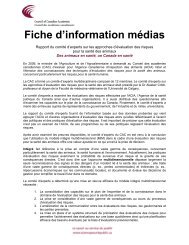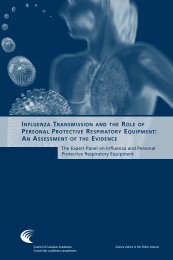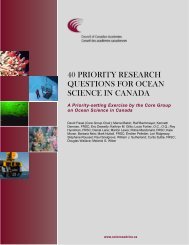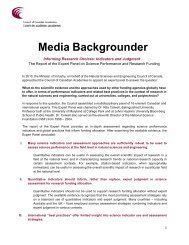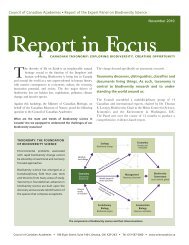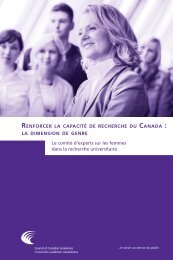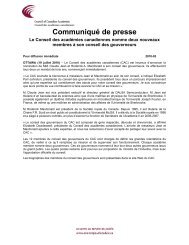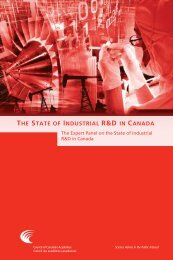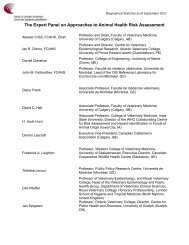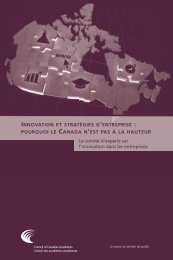IN CANADA, 2012 Appendices - Council of Canadian Academies
IN CANADA, 2012 Appendices - Council of Canadian Academies
IN CANADA, 2012 Appendices - Council of Canadian Academies
You also want an ePaper? Increase the reach of your titles
YUMPU automatically turns print PDFs into web optimized ePapers that Google loves.
10 The State <strong>of</strong> Science and Technology in Canada, <strong>2012</strong><br />
Migration patterns were also analyzed at the field level to uncover trends in<br />
different areas <strong>of</strong> research. The method used for this analysis was similar to that<br />
described above. However, this requires associating an AUID with a specific<br />
field <strong>of</strong> research. One field <strong>of</strong> research was associated with each AUID using a<br />
combination <strong>of</strong> the distribution <strong>of</strong> its papers across fields and a measure <strong>of</strong> the<br />
kurtosis <strong>of</strong> the scientific production towards one field. By constructing vectors <strong>of</strong><br />
the author’s share <strong>of</strong> production for each field and by computing the kurtosis <strong>of</strong><br />
each <strong>of</strong> these vectors, AUIDs were selected where the scientific production peaked<br />
around a single field. Using this technique, a large number <strong>of</strong> the researchers from<br />
the overall analysis presented earlier were assigned a specific field <strong>of</strong> research.<br />
Migration was then computed at the field level using these samples. This process<br />
resulted in lower numbers <strong>of</strong> usable AUIDs because some <strong>of</strong> the AUIDs could<br />
not be assigned to a specific field. To ensure the analysis was sufficiently robust,<br />
only the fields with at least 1,000 AUIDs were used in this analysis. This left<br />
seven fields for which researcher migration data was available: Information and<br />
Communication Technologies; Engineering; Chemistry; Clinical Medicine; Physics<br />
and Astronomy; Biomedical Research; and Enabling and Strategic Technologies.<br />
Cluster Analysis <strong>of</strong> Research Topics<br />
An analysis <strong>of</strong> clusters <strong>of</strong> related scientific research was also conducted for this<br />
study, which provides an alternative approach to relying on traditional discipline<br />
classification systems. Through an analysis <strong>of</strong> citation patterns, a cluster-based<br />
classification <strong>of</strong> research topics was produced to supplement more traditional<br />
journal-based classifications <strong>of</strong> science used for the majority <strong>of</strong> the bibliometric<br />
analysis in this report. Using an algorithm for the rapid unfolding <strong>of</strong> communities<br />
in large networks, Science-Metrix clustered 86 per cent <strong>of</strong> papers in the Scopus<br />
database (i.e., 16.1 million out <strong>of</strong> 18.8 million papers). These papers were grouped<br />
into about 48,000 clusters <strong>of</strong> related research, the majority (i.e., 98 per cent) <strong>of</strong><br />
which are smaller than 1,000 papers.<br />
To then identify the topical clusters that are interdisciplinary, researchers at<br />
Science‐Metrix computed the interdisciplinarity <strong>of</strong> each cluster’s respective<br />
papers based on the distribution <strong>of</strong> all references listed in each paper across the<br />
sub-fields (or disciplines) <strong>of</strong> the traditional journal-based classification used in<br />
this study. This is measured by defining a reference network and comparing it<br />
to a vector for all scientific sub-fields. (In this study, the reference network is the<br />
citation network <strong>of</strong> all Scopus papers published between 1996 and 2010). The<br />
vector <strong>of</strong> a given cluster is composed <strong>of</strong> the number <strong>of</strong> papers in the reference list<br />
<strong>of</strong> all the papers it contains in each sub-field, based on the selected classification.<br />
The result <strong>of</strong> this calculation is the interdisciplinary indicator for each topical<br />
cluster. As the interdisciplinarity indicator approaches 1.0, the cluster (or topic)





